Unless you've been living in a cave or don't have access to a TV, computer, smart phone, or even a newspaper, you likely know that Presidents Xi Jingping and Donald Trump laid the groundwork for a trade deal Saturday night in Buenos Aires. Generally referred to as a "truce" or cease fire in the current trade war, the key is that the two sides have agreed to a few things and to keep talking.
As such, no new tariffs will be applied by either side for 90 days. But after that, the details are skimpy at best, and many wonder if a deal involving issues such as forced technology transfers and intellectual property protection can actually get done in such a short period of time.
What we do know is our Negotiator-in-Chief tweeted over the weekend that he and Xi had agreed to what would amount to a "great deal." A deal where China says it will buy a bunch of stuff from the U.S. in order to close the trade gap between the two countries. Importantly, this includes agriculture as well as cars, technology and other industrial products.
We also know that stock markets around the globe like the news - a lot. The bottom line is simple. The second big, near-term fear - the fear that a prolonged trade war would damage the global economy - is now fading. In response, traders appear to be "discounting" the expectations for (1) a trade deal to get done and (2) reduced recession risk in developed markets.
Therefore, within one week, both of the key, near-term fears have been checked off. Recall that last week Jerome Powell eased fears that the Fed would be stubborn and "overshoot" - again hurting the economy in the process. And now we've got significantly reduced fears that China and the U.S. will become stubborn in their trade dispute.
Time For the Year-End Rally?
So, is it time to cue the traditional year-end, aka Santa Claus rally on Wall Street?
From the looks of the futures market, it would appear that Santa has loaded up his sleigh a bit early this year with gifts for stock and commodity market investors. Dow futures are pointing to a gain of over 425 points at the open. Oil is up 5%. Gold, copper, silver, and platinum are all up 1% or more. German's DAX is up 2%. London's FTSE is up 1.6%. France is up 0.8% (this despite the violent protests occurring in Paris). Italy is up 1.8%. Japan rallied 1%. China's Shanghai index rallied 2.57%.
This just in this morning... Treasury Secretary Mnunchin is saying that this deal represents significant opportunity for economic growth.
Can you say, "risk on?"
On that note, it would be easy to think that everything is all better now and that stocks are heading straight to new highs. However, it might be best to curb the year-end enthusiasm a bit.
Yes, Trump and Powell appear to have delivered a very nice holiday gift to the markets. And I have little doubt that the mood on the street will improve. However, it also important to keep in mind that global economies are slowing and that a great many foreign stock indices are in bear markets.
Yet, the bulls will argue that the removal of the two big, bad fears will go a long way in alleviating the global slowdown. We'll see.
All Clear?
Here at home, the bulls will likely enjoy the day. But from a chart perspective, there is an important line in the sand that needs to be breached - as in the November high.
S&P 500 - Daily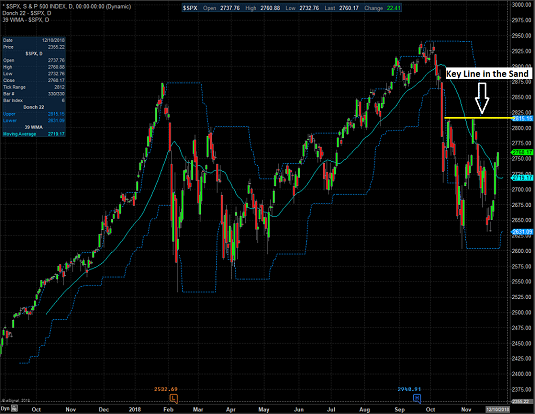
View Full Size Chart
Technicians tell us that if stocks can push through the November highs then the correction is over, and a new uptrend has begun. This should be marked by a series of "higher highs and higher lows" on the charts.
But if the bulls can't break on through to the other side, then our furry friends in the bear camp will contend that stocks will be at best, stuck in a bottoming process or, at worst, embarking on a new leg lower.
Personally, I'll put my money on the former as I would expect the S&P to push higher into the end of the year. A move that would reflect an improving macro environment.
But... As the saying goes, the devil is in the details. Rest assured that at some point - maybe not in December, but definitely within the next 60 days - traders will want to see some details of the trade deal. And more importantly, they will want assurances that a deal is actually going to get done.
But for now, at least, it is time to enjoy the bounce.
Now let's turn to the weekly review of my favorite indicators and market models...
The State of the Big-Picture Market Models
I like to start each week with a review of the state of my favorite big-picture market models, which are designed to help me determine which team is in control of the primary trend.
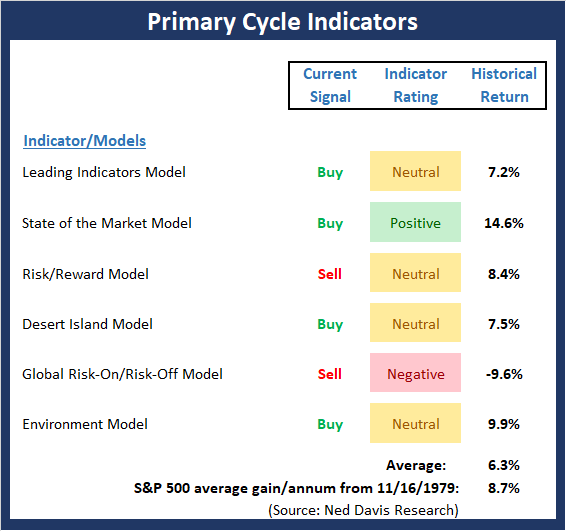
View My Favorite Market Models Online
The Bottom Line:
- There was one minor changes to the Primary Cycle board this week. My "Desert Island" model, which, as the name implies would be the one model I could rely on to manage money if stranded on a desert island without any other market inputs, slipped into the neutral zone. The good news is the model remains on a buy signal.
Note: We have added a new model to the Primary Cycle board. Since most big moves in the market tend to be global in scope, we've added a "risk-on/risk-off" model based on global markets. Unfortunately, this indicator remains negative at this time.
This week's mean percentage score of my 6 favorite models declined to 57.9 (from 64.5%) while the median fell to 52.5% (from 65%).
The State of the Trend
Once I've reviewed the big picture, I then turn to the "state of the trend." These indicators are designed to give us a feel for the overall health of the current short- and intermediate-term trend models.
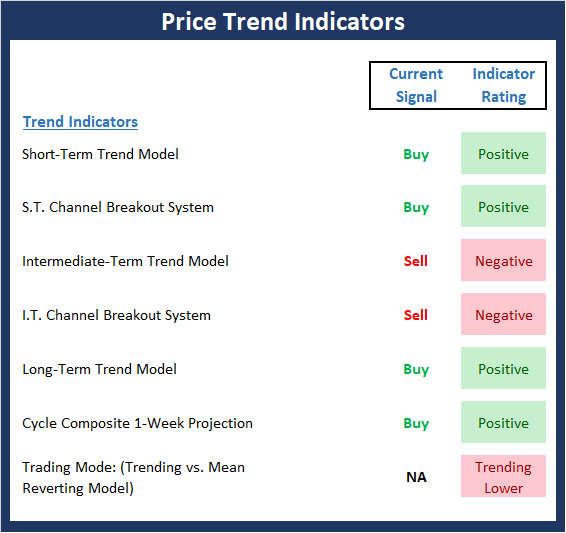
View Trend Indicator Board Online
The Bottom Line:
- As you might surmise from the strong rally seen last week, the Trend board perked up a bit - especially the short-term indicators. The bad news is that there was a fair amount damage done to the longer-term indicators and our trading mode model is now in its "trending lower" mode. However, it is positive that the Cycle Composite points higher from now until the end of the year.
The State of Internal Momentum
Next up are the momentum indicators, which are designed to tell us whether there is any "oomph" behind the current trend.
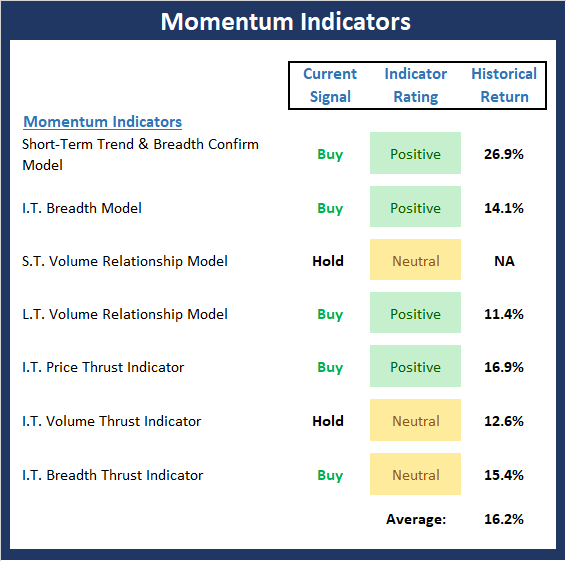
View Momentum Indicator Board Online
The Bottom Line:
- While this is a rarity, every indicator on the Momentum board improved last week. In addition, we saw two indications of "thrust" signals, which, if confirmed tend to be an "all clear" signal for the ensuing 12 months. And with the historical return upticking nicely, the bulls now have hope that the worst of the corrective phase is over.
The State of the "Trade"
We also focus each week on the "early warning" board, which is designed to indicate when traders might start to "go the other way" -- for a trade.

View Early Warning Indicator Board Online
The Bottom Line:
- The "Early Warning" board did a good job recently of indicating that the bulls, at the very least, had the winds at their backs for a rally try. While the board is nowhere near negative at this time, some of the strong signals have now "timed out." The bottom line is the board is now more neutral.
The State of the Macro Picture
Now let's move on to the market's "environmental factors" - the indicators designed to tell us the state of the big-picture market drivers including monetary conditions, the economy, inflation, and valuations.
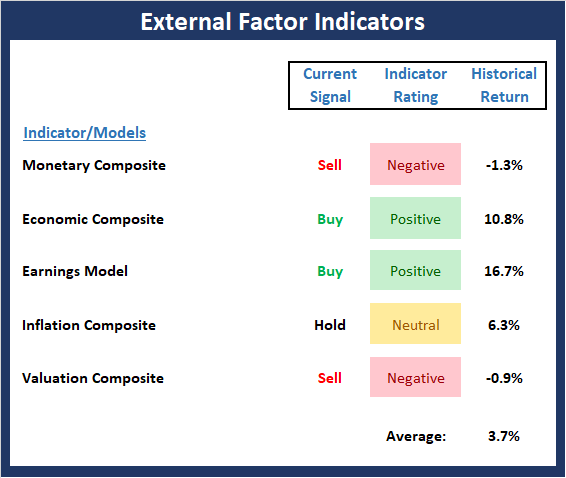
View Environment Indicator Board Online
The Bottom Line:
- While the indices have bounced and the bulls argue that the worst of the correction is over, the External Factors board continues to suggest that from a big-picture standpoint, risk factors remain elevated and return expectations are uninspiring. However, it is worth noting that the valuation components of our model are improving.
Thought For The Day:
Train people well enough so they can leave. Treat them well enough so they don't want to. -Richard Branson
Wishing you green screens and all the best for a great day,

David D. Moenning
Founder, Chief Investment Officer
Heritage Capital Research
HCR Focuses on a Risk-Managed Approach to Investing
What Risk Management Can and Cannot Do
ANNOUNCEMENT:
HCR Awarded Top Honors in 2018 NAAIM Shark Tank Portfolio Strategy Competition
Each year, NAAIM (National Association of Active Investment Managers) hosts a competition to identify the best actively managed investment strategies. In April, HCR's Dave Moenning took home first place for his flagship risk management strategy.
<hr>Disclosures
At the time of publication, Mr. Moenning held long positions in the following securities mentioned: none - Note that positions may change at any time.
Indicators Explained
Short-Term Trend-and-Breadth Signal Explained: History shows the most reliable market moves tend to occur when the breadth indices are in gear with the major market averages. When the breadth measures diverge, investors should take note that a trend reversal may be at hand. This indicator incorporates NDR's All-Cap Dollar Weighted Equity Series and A/D Line. From 1998, when the A/D line is above its 5-day smoothing and the All-Cap Equal Weighted Equity Series is above its 25-day smoothing, the equity index has gained at a rate of +32.5% per year. When one of the indicators is above its smoothing, the equity index has gained at a rate of +13.3% per year. And when both are below, the equity index has lost +23.6% per year.
Channel Breakout System Explained: The short-term and intermediate-term Channel Breakout Systems are modified versions of the Donchian Channel indicator. According to Wikipedia, "The Donchian channel is an indicator used in market trading developed by Richard Donchian. It is formed by taking the highest high and the lowest low of the last n periods. The area between the high and the low is the channel for the period chosen."
Intermediate-Term Trend-and-Breadth Signal Explained: This indicator incorporates NDR's All-Cap Dollar Weighted Equity Series and A/D Line. From 1998, when the A/D line is above its 45-day smoothing and the All-Cap Equal Weighted Equity Series is above its 45-day smoothing, the equity index has gained at a rate of +17.6% per year. When one of the indicators is above its smoothing, the equity index has gained at a rate of +6.5% per year. And when both are below, the equity index has lost -1.3% per year.
Cycle Composite Projections: The cycle composite combines the 1-year Seasonal, 4-year Presidential, and 10-year Decennial cycles. The indicator reading shown uses the cycle projection for the upcoming week.
Trading Mode Indicator: This indicator attempts to identify whether the current trading environment is "trending" or "mean reverting." The indicator takes the composite reading of the Efficiency Ratio, the Average Correlation Coefficient, and Trend Strength models.
Volume Relationship Models: These models review the relationship between "supply" and "demand" volume over the short- and intermediate-term time frames.
Price Thrust Model Explained: This indicator measures the 3-day rate of change of the Value Line Composite relative to the standard deviation of the 30-day average. When the Value Line's 3-day rate of change have moved above 0.5 standard deviation of the 30-day average ROC, a "thrust" occurs and since 2000, the Value Line Composite has gained ground at a rate of +20.6% per year. When the indicator is below 0.5 standard deviation of the 30-day, the Value Line has lost ground at a rate of -10.0% per year. And when neutral, the Value Line has gained at a rate of +5.9% per year.
Volume Thrust Model Explained: This indicator uses NASDAQ volume data to indicate bullish and bearish conditions for the NASDAQ Composite Index. The indicator plots the ratio of the 10-day total of NASDAQ daily advancing volume (i.e., the total volume traded in stocks which rose in price each day) to the 10-day total of daily declining volume (volume traded in stocks which fell each day). This ratio indicates when advancing stocks are attracting the majority of the volume (readings above 1.0) and when declining stocks are seeing the heaviest trading (readings below 1.0). This indicator thus supports the case that a rising market supported by heavier volume in the advancing issues tends to be the most bullish condition, while a declining market with downside volume dominating confirms bearish conditions. When in a positive mode, the NASDAQ Composite has gained at a rate of +38.3% per year, When neutral, the NASDAQ has gained at a rate of +13.3% per year. And when negative, the NASDAQ has lost at a rate of -12.1% per year.
Breadth Thrust Model Explained: This indicator uses the number of NASDAQ-listed stocks advancing and declining to indicate bullish or bearish breadth conditions for the NASDAQ Composite. The indicator plots the ratio of the 10-day total of the number of stocks rising on the NASDAQ each day to the 10-day total of the number of stocks declining each day. Using 10-day totals smooths the random daily fluctuations and gives indications on an intermediate-term basis. As expected, the NASDAQ Composite performs much better when the 10-day A/D ratio is high (strong breadth) and worse when the indicator is in its lower mode (weak breadth). The most bullish conditions for the NASDAQ when the 10-day A/D indicator is not only high, but has recently posted an extreme high reading and thus indicated a thrust of upside momentum. Bearish conditions are confirmed when the indicator is low and has recently signaled a downside breadth thrust. In positive mode, the NASDAQ has gained at a rate of +22.1% per year since 1981. In a neutral mode, the NASDAQ has gained at a rate of +14.5% per year. And when in a negative mode, the NASDAQ has lost at a rate of -6.4% per year.
Short-Term Overbought/sold Indicator: This indicator is the current reading of the 14,1,3 stochastic oscillator. When the oscillator is above 80 and the %K is above the %D, the indicator gives an overbought reading. Conversely, when the oscillator is below 20 and %K is below its %D, the indicator is oversold.
Intermediate-Term Overbought/sold Indicator: This indicator is a 40-day RSI reading. When above 57.5, the indicator is considered overbought and when below 45 it is oversold.
Mean Reversion Model: This is a diffusion model consisting of five indicators that can produce buy and sell signals based on overbought/sold conditions.
VIX Indicator: This indicator looks at the current reading of the VIX relative to standard deviation bands. When the indicator reaches an extreme reading in either direction, it is an indication that a market trend could reverse in the near-term.
Short-Term Sentiment Indicator: This is a model-of-models composed of 18 independent sentiment indicators designed to indicate when market sentiment has reached an extreme from a short-term perspective. Historical analysis indicates that the stock market's best gains come after an environment has become extremely negative from a sentiment standpoint. Conversely, when sentiment becomes extremely positive, market returns have been subpar.
Intermediate-Term Sentiment Indicator: This is a model-of-models composed of 7 independent sentiment indicators designed to indicate when market sentiment has reached an extreme from an intermediate-term perspective. Historical analysis indicates that the stock market's best gains come after an environment has become extremely negative from a sentiment standpoint. Conversely, when sentiment becomes extremely positive, market returns have been subpar.
Long-Term Sentiment Indicator: This is a model-of-models composed of 6 independent sentiment indicators designed to indicate when market sentiment has reached an extreme from a long-term perspective. Historical analysis indicates that the stock market's best gains come after an environment has become extremely negative from a sentiment standpoint. Conversely, when sentiment becomes extremely positive, market returns have been subpar.
Absolute Monetary Model Explained: The popular cliché, "Don't fight the Fed" is really a testament to the profound impact that interest rates and Fed policy have on the market. It is a proven fact that monetary conditions are one of the most powerful influences on the direction of stock prices. The Absolute Monetary Model looks at the current level of interest rates relative to historical levels and Fed policy.
Relative Monetary Model Explained: The "relative" monetary model looks at monetary indicators relative to recent levels as well as rates of change and Fed Policy.
Economic Model Explained: During the middle of bull and bear markets, understanding the overall health of the economy and how it impacts the stock market is one of the few truly logical aspects of the stock market. When our Economic model sports a "positive" reading, history (beginning in 1965) shows that stocks enjoy returns in excess of 21% per year. Yet, when the model's reading falls into the "negative" zone, the S&P has lost nearly -25% per year. However, it is vital to understand that there are times when good economic news is actually bad for stocks and vice versa. Thus, the Economic model can help investors stay in tune with where we are in the overall economic cycle.
Inflation Model Explained: They say that "the tape tells all." However, one of the best "big picture" indicators of what the market is expected to do next is inflation. Simply put, since 1962, when the model indicates that inflationary pressures are strong, stocks have lost ground. Yet, when inflationary pressures are low, the S&P 500 has gained ground at a rate in excess of 13%. The bottom line is inflation is one of the primary drivers of stock market returns.
Valuation Model Explained: If you want to get analysts really riled up, you need only to begin a discussion of market valuation. While the question of whether stocks are overvalued or undervalued appears to be a simple one, the subject is extremely complex. To simplify the subject dramatically, investors must first determine if they should focus on relative valuation (which include the current level of interest rates) or absolute valuation measures (the more traditional readings of Price/Earnings, Price/Dividend, and Price/Book Value). We believe that it is important to recognize that environments change. And as such, the market's focus and corresponding view of valuations are likely to change as well. Thus, we depend on our Valuation Models to help us keep our eye on the ball.
<hr>Disclosures
The opinions and forecasts expressed herein are those of Mr. David Moenning and may not actually come to pass. Mr. Moenning's opinions and viewpoints regarding the future of the markets should not be construed as recommendations. The analysis and information in this report is for informational purposes only. No part of the material presented in this report is intended as an investment recommendation or investment advice. Neither the information nor any opinion expressed constitutes a solicitation to purchase or sell securities or any investment program.
Any investment decisions must in all cases be made by the reader or by his or her investment adviser. Do NOT ever purchase any security without doing sufficient research. There is no guarantee that the investment objectives outlined will actually come to pass. All opinions expressed herein are subject to change without notice. Neither the editor, employees, nor any of their affiliates shall have any liability for any loss sustained by anyone who has relied on the information provided.
Mr. Moenning may at times have positions in the securities referred to and may make purchases or sales of these securities while publications are in circulation. Positions may change at any time.
The analysis provided is based on both technical and fundamental research and is provided "as is" without warranty of any kind, either expressed or implied. Although the information contained is derived from sources which are believed to be reliable, they cannot be guaranteed.
Investments in equities carry an inherent element of risk including the potential for significant loss of principal. Past performance is not an indication of future results.
Recent free content from FrontRange Trading Co.
-
 Is The Bull Argument Too Easy These Days?
— 8/31/20
Is The Bull Argument Too Easy These Days?
— 8/31/20
-
 What Do The Cycles Say About 2020?
— 1/21/20
What Do The Cycles Say About 2020?
— 1/21/20
-
 Modeling 2020 Expectations (Just For Fun)
— 1/13/20
Modeling 2020 Expectations (Just For Fun)
— 1/13/20
-
 Tips From Real-World Wendy Rhoades
— 5/06/19
Tips From Real-World Wendy Rhoades
— 5/06/19
-
 The Best Recession Ever!
— 4/29/19
The Best Recession Ever!
— 4/29/19



